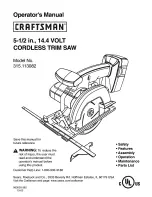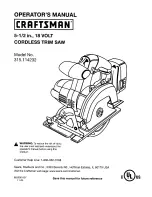
Mitre gauge:
Place the mitre gauge in the table
T-slot.
If the mitre gauge is not square loosen the lock knob (C, Fig 9)
and adjust the pointer (D).
For the authorized use of the machine observe the
appendix A
“safe operation“
(on the last pages of this operating manual)
A.1: Performing high cuts
A.2.: Performing diagonal cuts
A.3.: Tenon cutting
A.4.: Cutting of wedges
A.5.: Curved cuts
A.6.: Arc cuts
A.7.: Cutting with template
A.8.: Circular cutting
A8.1 Set up without workpiece
A8.2 Placing the workpiece
A8.3 Machining
7. Setup and adjustments
General note:
Setup and adjustment work may only be carried out after
the machine is protected against accidental starting by
pulling the mains plug.
7.1 Saw blade selection
The sawblade has to meet the technical specification.
Choose a suitable sawblade, according to the cutting
operation and according to the material to be cut.
For a high rip cut:
- use a wide sawblade, coarse teethed
(e.g. 20mm, 3 T/”)
For a narrow curved cut:
- use a narrow sawblade
(e.g. 3mm, 14 T/”).
Pitch:
The pitch should not be smaller than necessary, as the feed
speed is reduced if there are too many teeth working on the
workpiece simultaneously, which causes the saw blade to
wear more quickly.
Ideally, 3 to 12 teeth should be in action at the same time (Fig
11).
Fig 11
The following table shows recommended saw blade pitch in
relation to workpiece thickness (Fig 12).
Fig 12
Tooth Shape:
The tooth shape effects the chip capacity and the feed rate.
The following table shows common tooth shapes (Fig 13):
Fig 13
A- Regular tooth:
The most common used tooth shape. 0° rake angle.
Suited for cut-off and contour sawing of most materials. For
cutting materials where a fine cut is required.
B- Skip tooth:
Widely spaced teeth, to prevent clogging. 0°rake angle.
For resawing and ripping thick stock, especially soft woods.
Summary of Contents for JWBS-16X
Page 39: ...1 A1 A2 A3 A4 ...
Page 40: ...2 A5 A6 A7 ...
Page 41: ...3 A8 1 A8 2 A8 3 ...
Page 42: ......
Page 43: ......
Page 44: ......










































